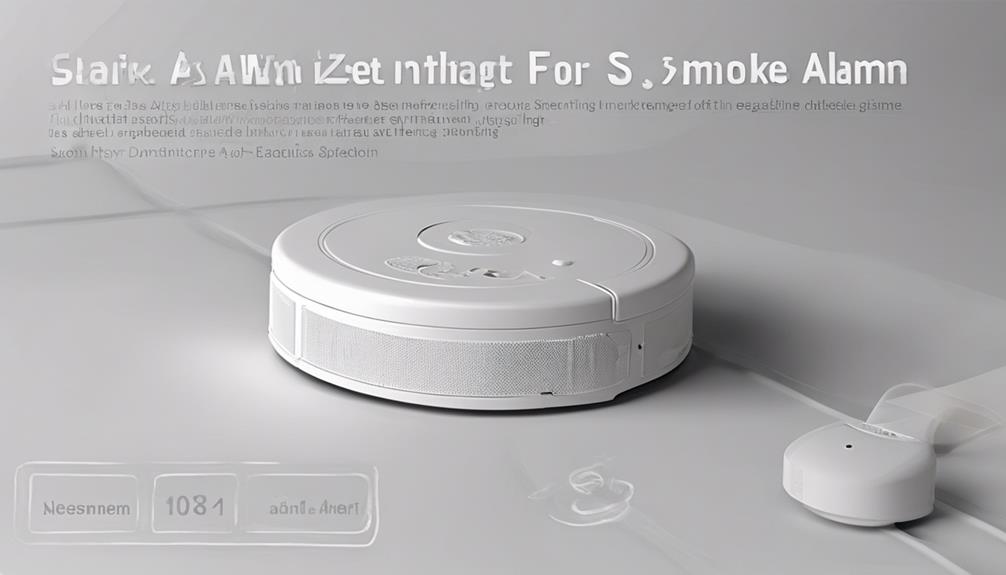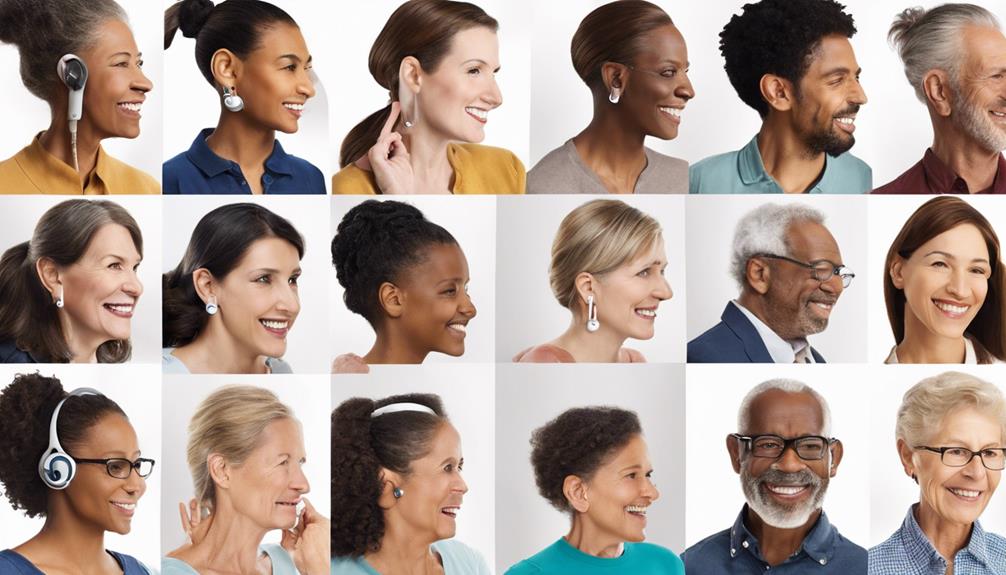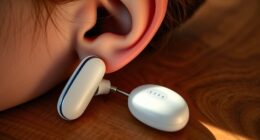Did you know that deaf individuals can get free smoke alarms?
The process may seem daunting at first, but with the right guidance and resources, it can be a straightforward endeavor that significantly enhances safety within homes.
By following specific steps and understanding eligibility criteria, deaf individuals can secure these crucial devices without incurring any costs.
Let's explore the avenues available to ensure the safety of our community members who are deaf or hard of hearing.
Key Takeaways
- Specialized alarms with visual and tactile alerts are crucial for alerting deaf individuals to fires.
- Free smoke alarms tailored for the deaf are available through specific eligibility criteria.
- Contact the Mayor's Office for People with Disabilities or the Fire Department for assistance.
- Regular maintenance and testing of alarms are vital for ensuring optimal safety for the deaf community.
Importance of Smoke Alarms for Deaf Individuals
Ensuring the safety of deaf individuals in the event of a fire necessitates the use of specialized smoke alarms equipped with strobe lights and bed shakers for visual and tactile alerts. These alarms play a critical role in alerting individuals who are hard of hearing to the presence of smoke or fire in their homes. Working smoke alarms are essential for everyone, but they're particularly crucial for the deaf community as they reduce the risk of fire-related deaths by 50%. By providing visual and tactile alerts, these alarms enable prompt evacuation during emergencies.
Free smoke alarms tailored for deaf individuals are instrumental in bridging the safety gap and ensuring their protection. These alarms not only offer peace of mind but also serve as life-saving devices. Additionally, advancements like connecting devices such as Google Nest to standard smoke detectors further enhance the safety measures for deaf individuals, offering them additional layers of protection in case of a fire.
Eligibility Requirements for Free Alarms

For those seeking free smoke alarms tailored for deaf or hard of hearing individuals, meeting specific eligibility requirements in Houston is essential. To qualify for the Free Smoke Alarm program, individuals must be non-renters residing in Houston and meet low-income, physically challenged, or senior criteria. The initiative by the Houston Fire Department is designed to assist those who lack functioning smoke alarms in their homes, particularly targeting individuals with disabilities. The limited availability of free visual fire alarms is allocated based on these specific qualifications to ensure that those most in need receive assistance.
Individuals interested in obtaining free smoke alarms can apply by calling the Mayor's Office for People with Disabilities (MOPD) or reaching out to the Public Affairs Division for guidance. The primary goal of this program is to address the unique safety requirements of the deaf community by providing specialized smoke alarms at no cost, enhancing fire protection for individuals facing hearing challenges.
How to Locate Free Alarm Programs
To find free alarm programs for the deaf or hard of hearing in Houston, individuals can contact various organizations and departments dedicated to providing assistance and resources.
One option is to reach out to the Houston Fire Department's Get Alarmed Houston program, which offers free smoke alarms tailored to the needs of the deaf community.
Additionally, contacting the Mayor's Office for People with Disabilities (MOPD) at 713-284-1990 or via email at mopdmail@houstontx.gov can lead to obtaining free smoke alarms.
For further information on acquiring free smoke alarms for the deaf, individuals can check with the Public Affairs Division at 832-394-6633.
Exploring partnership programs such as DNCAP and MI Prevention is another avenue to access free smoke detectors and assistive technology for those who are deaf or hard of hearing.
Organizations like the American Red Cross also provide free fire alarm installation, which includes special devices designed for the deaf and hard of hearing community.
Application Process for Free Alarms

The process to obtain free smoke alarms for the deaf involves contacting the Mayor's Office for People with Disabilities (MOPD) at 713-284-1990 or emailing mopdmail@houstontx.gov.
To begin the application process, individuals must meet specific qualifications, such as being a non-renter, residing in Houston, and falling into categories like low-income, physically challenged, or a senior with a fixed income.
As there's a limited supply of alarms available, individuals seeking assistance can contact the Public Affairs Division at 832-394-6633. The program relies on donations or grants to provide all smoke alarms, and interested companies can contribute by contacting the Public Affairs Division at the same number.
In cases where landlords don't provide smoke alarms, individuals can seek support from the Fire Marshal Office to acquire one. By following these steps and meeting the criteria, eligible individuals can access the necessary free smoke alarms designed for the deaf community.
Tips for Maintaining Smoke Alarms
Regularly testing, replacing batteries, and cleaning smoke alarms are essential maintenance tasks to ensure their optimal performance in detecting potential fire hazards.
Test your smoke alarms monthly by pressing the test button to verify they're functioning correctly. Replace the batteries at least once a year or when you hear the low battery chirp to keep them working at their best.
Vacuum the smoke alarms regularly to remove dust and debris, preventing malfunctions and false alarms. For comprehensive coverage, install smoke alarms in every bedroom, outside each sleeping area, and on every level of your home.
Follow the manufacturer's guidelines for maintenance and replacement to maximize the effectiveness of your smoke alarms in alerting you to fire hazards. By staying proactive with these maintenance tips, you can help ensure the safety of your home, especially for individuals who are deaf or hard of hearing.
Frequently Asked Questions
Can I Get Smoke Alarms for Free?
Yes, we can help you get free smoke alarms. Our program offers specialized alarms for the deaf or hard of hearing. These alarms are provided at no cost to eligible individuals in Houston.
Donations and grants support this initiative, ensuring access to crucial fire safety devices. Our goal is to enhance safety by installing 2,000 smoke detectors with the help of grants from FEMA and DHS.
Contact us to secure your free smoke alarm today.
How Do Deaf People Have Smoke Alarms?
Deaf individuals ensure their safety with specialized smoke alarms. Strobe lights and bed shakers alert them in emergencies. Google Nest devices can also connect standard alarms for notifications. These innovations offer timely warnings for those with hearing impairments.
Installation assistance is provided for free, securing essential fire safety devices.
Can You Get Free Smoke Detectors From Your Local Fire Department?
Yes, we can get free smoke detectors from our local fire department. They provide this vital safety equipment through programs like Get Alarmed Houston. These initiatives target individuals who are deaf or hard of hearing to ensure their safety during fires.
It's crucial to reach out to our local fire department or organizations like MI Prevention for assistance in obtaining these life-saving alarms. It's a great way to enhance our safety at no cost.
Is There a Vibrating Fire Alarm for the Deaf for Guests at Hotels?
Yes, hotels offer vibrating fire alarms for deaf guests. These alarms use bed shakers to alert individuals with hearing impairments in case of a fire. Providing these specialized accessibility features shows a commitment to inclusivity and safety for all guests.
When making reservations or at check-in, guests can inquire about the availability of vibrating fire alarms. This ensures equal access to safety measures in hospitality settings, promoting a welcoming and secure environment.
Can Deaf-Friendly Smoke Alarms Be Provided for Online Church Services?
Is it possible to provide deaf-friendly smoke alarms for online deaf church services? Ensuring the safety of all members, including those with hearing impairments, is crucial. Innovative technology and visual alert systems can be incorporated to make online church services accessible and safe for the deaf community.
Conclusion
In conclusion, obtaining free smoke alarms for the deaf is crucial for ensuring the safety and well-being of individuals in Houston. Remember, 'an ounce of prevention is worth a pound of cure,' so don't wait to take advantage of programs like Get Alarmed Houston.
By following the outlined steps and maintaining your smoke alarms, you can help prevent potential fire disasters and protect your loved ones. Stay safe and be proactive in fire safety measures.











